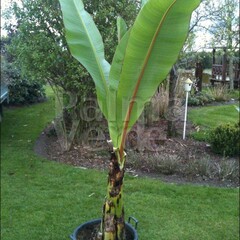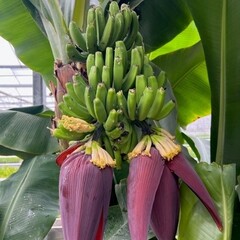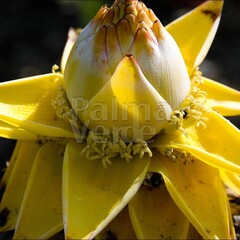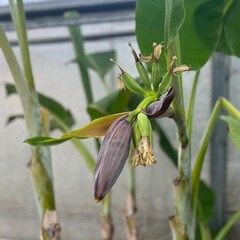The Musa basjoo is kept in Japan (Ryukyu Islands) for its fibers, of which books are bound. Originally the Musa basjoo comes from China. Of course, this garden banana requires a lot of water and fertilization during the summer months from April to September.
This immediately translates into a very explosive growth. This is the most sold hardy banana.
In winter, little water and hibernate at a temperature above freezing is not a problem.
This Musa basjoo is the most hardy banana that exists. We have a couple in the ground every year.
The old mother plants did not survive the winter. However, new shoots appeared from the roots in April.
If this banana is allowed to overwinter outdoors, properly cover the soil around the banana with a layer of mulch so that the frost can not affect the roots.
Because from the roots this banana plant has to come back in the spring.
At temperatures below +5 degrees the growth of the banana stops, at -2 degrees the leaves break. At even lower temperatures, the trunk freezes and eventually disappears completely.
If you want the banana to have a bigger back the following year, the trunk must be properly insulated using straw, reed mats etc. Cut off the remaining leaves and pack the stem lightly but pack it well.
We ourselves prefer to dig out the Musa basjoo and put it in a tub. If your Japanese fiber banana has become too high to overwinter indoors, you can safely cut off the stem to a length that does fit.
Now be back with water when the banana overwintering cool. On the ground you can for example sprinkle a layer of old horse manure or cow manure pellets in the spring.
The banana will now grow from the conserved trunk and become even larger as the year before, or if you wintered it in a tub planting back into the ground.
It is even possible to get the Musa basjoo to bloom. After this, the plant will die off, but new plants will emerge from the rhizomes.
This process continues to repeat itself.
The bananas of this species are not edible. Well that of the Musa sikkimensis that will certainly grow so large, these are also available. However, the Musa basjoo can also be kept in a large tub as a tub plant.
Give plenty of water in the summer and a gift of organic or liquid manure every two weeks from April to July.
You will be amazed by the growth of Musa basjoo, he can develop leaves of up to 1.50 meters in length. This banana is a must for your garden to decorate a tropical corner. Should it be a bit sheltered from the wind, otherwise the blade can tear (this is not harmful to the banana). When shipping the bananas in a package, it is possible that we are cutting back the sheet of bananas. These grow back very quickly.
Winter hardiness zone 6b (-20ºC).























